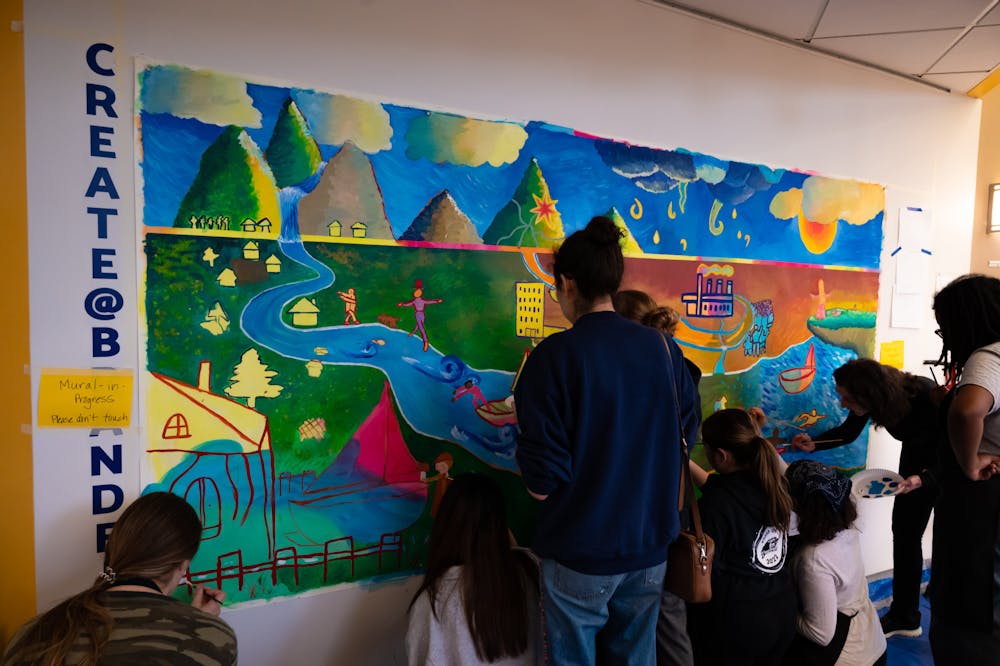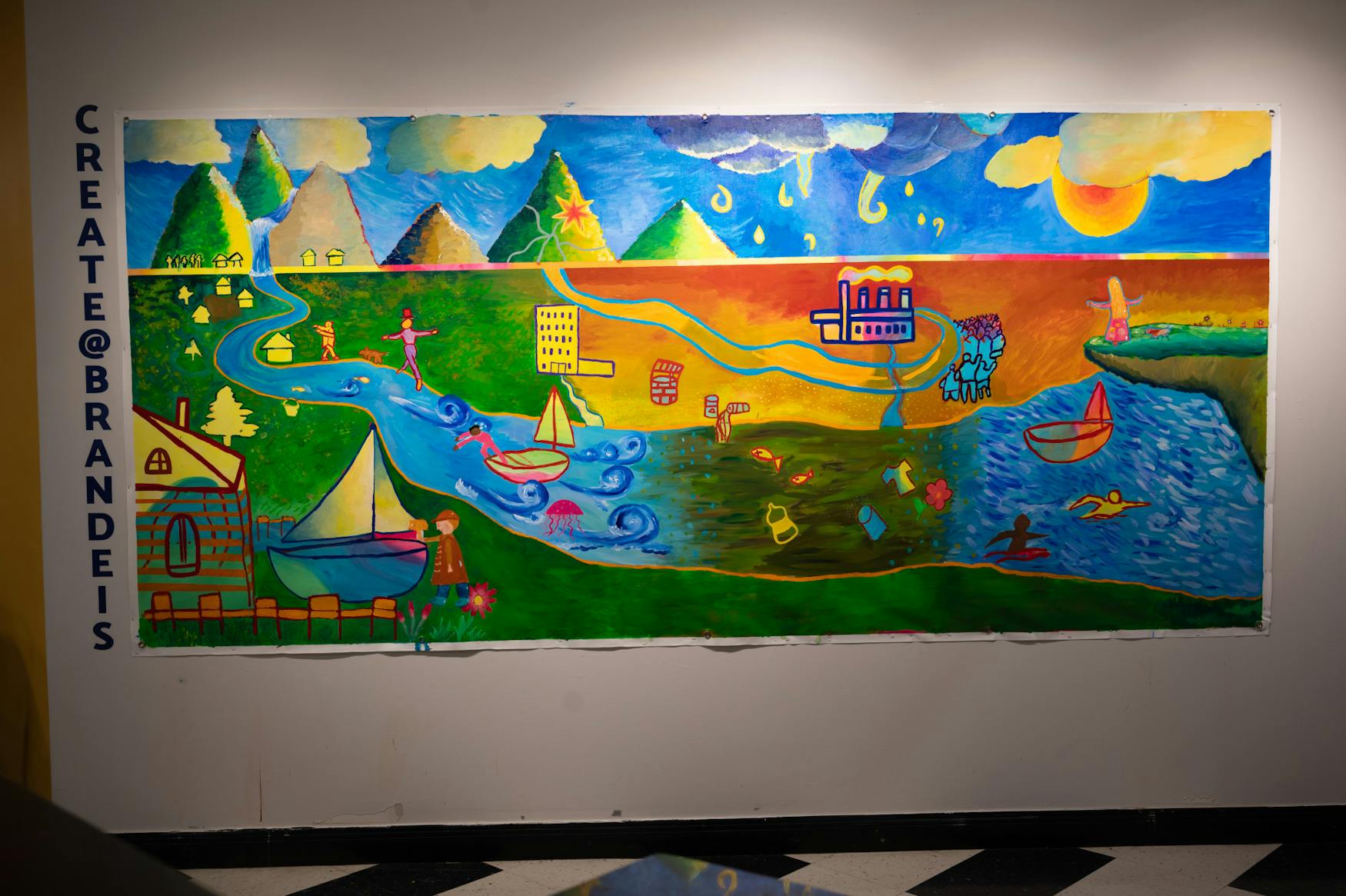Brandeis CAST presents 'Walls of Hope': A reflection on painting for progress
"There is nothing more efficient for changing people's perspectives than a good story, and I think murals are great stories."
– Argentinian artist and activist Claudia Bernardi
During the first week of November, you may have noticed a vibrant and lively mural making its way onto the Create@Brandeis wall of Upper Usdan. Unlike many of the other artworks we have seen as we pass through Usdan, “Walls of Hope: Brandeis” is not the work of a singular student or club of artists — it is instead a rather unconventional project assigned to the 18 students of Prof. Toni Shapiro-Phim’s (CAST) “Introduction to Creativity, the Arts, and Social Transformation” class. Students were tasked with working together to create a dynamic mural commenting on the politics, beauty, and perception of water as seen by various members of our community. Prior to painting the mural, the CAST students interviewed other Brandeis students in order to understand their relationship to water. The students of Shapiro-Phim’s class then attempted to translate these interviews into physical art. Along with Prof. Shapiro-Phim, Claudia Bernardi, a human rights advocate and community artist from Buenos Aires, Argentina, facilitated the mural’s creation. On Nov. 9, I had the pleasure of interviewing Bernardi and learning about how she uses art to give a voice to many forgotten communities.

Although she has done a lot of incredible work, one of Bernardi’s most significant projects is the “Walls of Hope School of Art and Open Studio” of Perquin, El Salvador. Bernardi founded this school in 2005 after she worked as a cartographer with the Argentine Forensic Psychology Team exhuming the bones of those who lost their lives in massacres in El Mozote, El Salvador. During this project, they exhumed the bones of 143 people, 136 of whom were children under the age of 12. According to Bernardi, this experience “changed [her] life.” As she continued her work, she questioned “what it would be like to come here and to work in projects of art with children of the same age of the ones we are exhuming today.” From this one question, the “Walls of Hope” school was born just miles away from the original site of the El Mozote murders. Through the Perquin school, Bernardi brought the art of mural-making to young students, thus formulating the connection between community, art, and education.
The mission of “Walls of Hope” continued beyond Perquin. Over the next 18 years, Bernardi and her team brought the Perquin model of using collaborative art to share the community’s truths and inspire people to listen to everyone’s voice. In light of “Walls of Hope’s” work with survivors of immense trauma and violence, I began to question the place such a project has in a private liberal arts University. What community truth was there for our student body to share?
Before speaking with Bernardi, I was admittedly cynical about a community mural’s impact on an insular college campus — an environment in which many students benefit from some degree of privilege. However, Bernardi reminded me of how the artistic process alone is a much-needed exercise in communication and compassion. According to Bernardi, the way she facilitates the mural-making process requires students to trust, listen, and honor the ideas of their classmates and the people they interviewed. She said, “what makes the mural a good idea for a university is to bring a different kind of learning together, without any competition, with collaboration.”
I find the beauty of this project to lie in the fact that the artistic process transcends the usual boundaries we face in an academic environment. A collective mural almost alleviates the stress of individual achievement, inspiring students to invest in the success of their peers. As such, the mural in Upper Usdan reflects the perspectives of so many Brandeis students.
“Walls of Hope: Brandeis” depicts the stories and hopes of both international and domestic students regarding their relationship to water. On the left side of the mural, students painted a whimsical scene illustrating a past in which humans had access to clean water and were more connected to our natural environment. People are fishing in sailboats. There are lush green fields, clear skies, and individuals ambling along the riverbanks. However, as one moves toward the right, the bright green turns to a cloudy orange, the sky darkens, and the green fields transition to an urbanized world. This section of the painting represents students’ present understanding of water in this world. They highlight the perils of water pollution, climate change, and the role of unbridled industrialization in destroying the environment.
However, the story the CAST students choose to tell is not one of despair. The far right of the painting demonstrates their collective vision for the future. The stormy skies give way to warm sunshine, and people are once again seen enjoying the beauty of the world and water. This mural is an amalgamation of the hopes and views of various students worldwide, formed by an effort to listen and connect with each other.

HAPPY PAINTING: Students Bella Cameran '24 and Maytal Storm '24 laugh while painting grass.
This mural ultimately tells a tale of Brandeis students’ past, present, and hopefully future with water — provided we choose to buy into the story told and act to create such a future. As Bernardi explained, murals tell stories that can inform perspectives. The implications of this artwork extend well beyond the bonding of a group of students. It rather serves as a literal backdrop for us to have and instigate broader conversations around people’s experiences with climate change and water pollution. An interesting thing about “Walls of Hope: Brandeis” is that it was painted on a flexible canvas, meaning it can be transported to various locations on campus and in our community. Bernardi hopes that we “make the borders of the University more permeable and make the mural transit outside of the safety of Brandeis.” After bearing witness to the work and efforts of the CAST students to honor the stories of those around them, we can join the communal effort to continue necessary conversations about our histories and futures.
My conversation with Bernardi felt incredibly relevant to the current climate at Brandeis. I am not the first, nor will I be the last, to say that it has been incredibly stressful to exist on campus right now. However, her words and the work of the CAST students present a possible way forward. This is not to say that a mere mural and a conversation will solve everything, but perhaps attempting to listen to each other is a place to start.
— Editor’s Note: Justice Photo editor Eliza Bier’ 26 and Justice Layout editor Anna Martin ’26 are students in the CAST class and did not contribute to or edit this story.



Please note All comments are eligible for publication in The Justice.